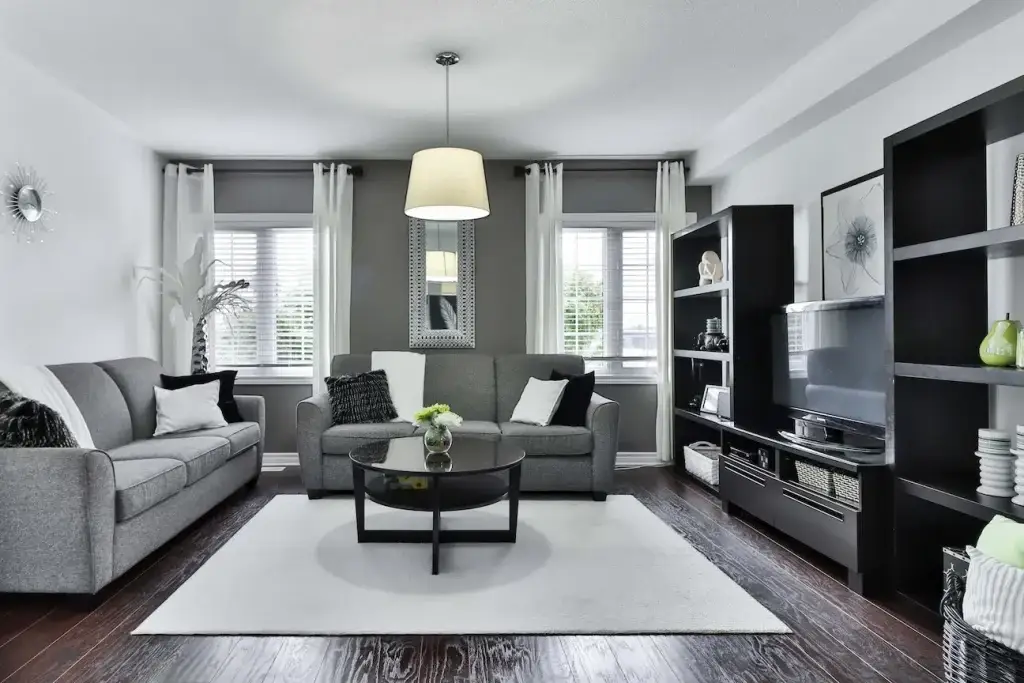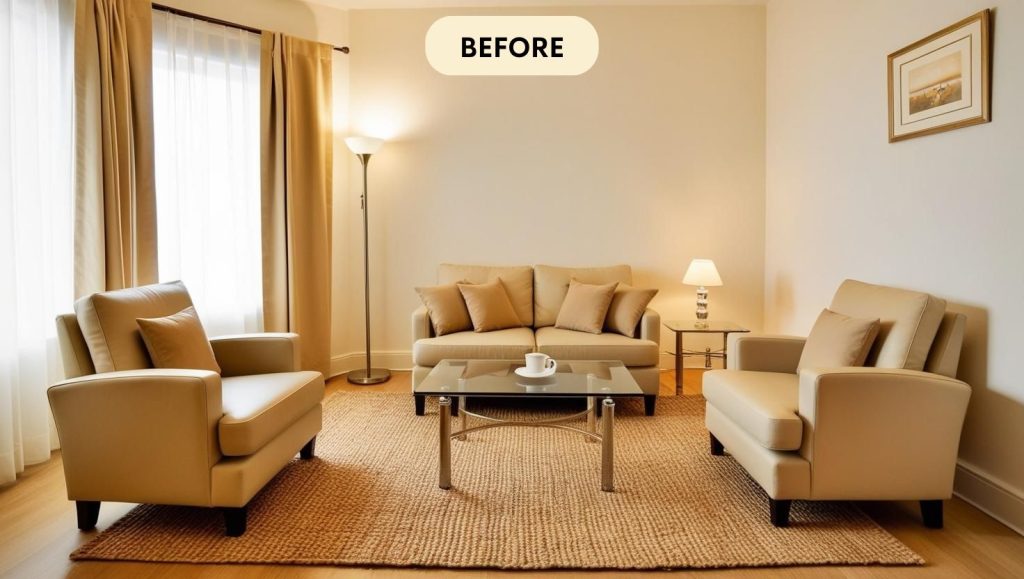Please see my disclosure policy for affiliate links, ads, and the use of AI.
We’ve all been there.
You spend hours scrolling through Pinterest, flipping through home magazines, and maybe even splurging on that perfect set of furniture.
You want your space to look polished, put-together, and stylish.
Create a space you love – grab a copy of the DIY Home Decor Planning Kit and get started today.
But then, despite all your efforts, something feels off.
Instead of looking effortlessly chic, your home looks… well, tacky.
And the culprit? Overly matchy-matchy decor.
I totally get why this happens – and I’m definitely guilty of this!
When you’re decorating, it’s easy to think that everything should match perfectly.
Furniture stores certainly don’t help, with their fully coordinated sets that make it seem like buying everything from one collection is the key to a well-designed space.
But in reality, a home that is too perfectly matched can feel sterile, uninspired, and, ironically, cheap.
Why Over-Matching Looks Tacky
At first glance, matching everything seems like a safe choice.

You don’t have to worry about colors clashing or styles looking out of place.
But here’s the problem: when every single piece in a room matches too well – same color, same fabric, same materials – it removes any sense of personality and depth.
Instead of looking like a thoughtfully designed space, it ends up looking like a showroom floor.
Think about the last time you walked into a high-end designer home or a beautifully decorated boutique hotel.
Did everything look identical? Probably not.
What makes those spaces stand out is the mix of textures, styles, and colors that create visual interest.
On the other hand, when a home is too coordinated, it can feel artificial, like it was put together in one day without any real thought or personal touch.
Common Over-Matching Mistakes
So, what does overly matchy-matchy decor actually look like?

Photo: Linda Merrill Interior Design
Here are a few common mistakes that make a home feel less sophisticated:
Buying Full Furniture Sets: While it might be tempting to purchase an entire matching living room or bedroom set, this often leads to a space that lacks variety.
When your sofa, loveseat, and armchair are all the exact same color and fabric, it can make your living room look monotonous.
Sticking to Just One Color: A home that is drenched in one color (especially neutrals like beige, gray, or white) can look flat and uninspired.
A pop of color or contrast helps create depth and energy in a space.
Overuse of One Material : Whether it’s all-glass furniture, too much wood in the same finish, or an overload of chrome accents, using just one material throughout a space can make it feel dull and overly coordinated.
Perfectly Matched Accessories : If your pillows match your curtains, which match your rug, which match your lampshade – it’s too much.
A little variation can go a long way in making a space feel more inviting and natural.
How to Fix Overly Matchy-Matchy Decor
The good news? If your home falls into the matchy-matchy trap, it’s an easy fix.
Steal the Style! Snag a copy of the DIY Home Decor Planning Kit and make decorating your space a total breeze.

Here are some ways to bring variety, personality, and sophistication back into your space:
Mix Textures and Materials : One of the easiest ways to make a room feel more dynamic is by combining different textures.
Try mixing soft fabrics like velvet with rougher materials like linen or wood.
Pairing sleek metals with natural elements like rattan or stone can also add contrast and depth.
Incorporate a Variety of Colors: Instead of sticking to just one shade, choose a cohesive color palette that includes complementary tones.
If you love neutrals, add depth with warm or cool undertones.
If you prefer color, use a mix of bold and muted shades to create balance.
Blend Different Furniture Styles : A home that looks curated over time (rather than purchased all at once) always feels more high-end.
Try mixing modern pieces with vintage finds, or pair contemporary furniture with classic or rustic accents.
This creates a collected-over-time aesthetic that feels natural and inviting.
Layer Your Accessories: When it comes to styling shelves, coffee tables, and countertops, layering is key.
Instead of perfectly matching decor, mix different heights, shapes, and styles.
For example, place a tall vase next to a stack of books with a small sculpture on top.
This kind of variation keeps the eye moving and makes the space feel more dynamic.
Break Up Matching Sets: If you already have a full furniture set, don’t worry.
You don’t have to replace everything.
Try moving pieces to different rooms, swapping out accessories, or reupholstering a chair in a contrasting fabric to break up the uniformity.
Introduce Statement Pieces: A single bold statement piece – whether it’s an oversized mirror, a unique light fixture, or an eye-catching piece of art – can serve as a focal point that draws attention away from overly matched elements.
Real-Life Example: A Living Room Transformation
I recently helped a friend redo her living room, and she had fallen into the matchy-matchy trap without even realizing it.
Her beige sofa had matching beige chairs, a beige rug, and beige curtains.
The result? It felt lifeless.
#1 We started by introducing some contrast.
#2 We swapped out one of the beige chairs for a deep navy accent chair and added throw pillows with varying textures and patterns.
#3 A dark wood coffee table replaced her glass one to bring in warmth, and we added a statement piece – a large, bold piece of artwork above the couch.
The result was night and day.
The space still felt cohesive but now had character, depth, and a much more expensive look.
Note: I didn’t think at the time to take a before and after photo!
So I’ve created 2 images with AI to give you an idea of what we acieved.
Two AI generated images:


Final Thoughts
If you’ve fallen into the overly matchy-matchy decor trap, don’t worry – it’s an easy fix!
The key to a stylish, sophisticated home is creating a balance between cohesion and contrast.
By mixing textures, incorporating different colors, and breaking up identical furniture sets, you can transform your home from predictable to effortlessly elegant.
Remember, the best-designed homes feel personal, layered, and full of character.
So, don’t be afraid to mix it up!





